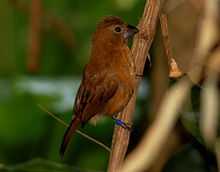Ultramarine Grosbeak
| Ultramarine Grosbeak | |
|---|---|
 | |
| Male in Registro, São Paulo, Brazil | |
 | |
| female | |
| Conservation status | |
| Scientific classification | |
| Kingdom: | Animalia |
| Phylum: | Chordata |
| Class: | Aves |
| Order: | Passeriformes |
| Family: | Cardinalidae |
| Genus: | Cyanocompsa |
| Species: | C. brissonii |
| Binomial name | |
| Cyanocompsa brissonii (Lichtenstein, 1823) | |
| Synonyms | |
|
Passerina brissonii (Lichtenstein, 1823) | |
The Ultramarine Grosbeak (Cyanocompsa brissonii) is a species of cardinal in the Cardinalidae family. It is found in a wide range of semi-open habitats in eastern and central South America, with a disjunct population in northern South America.
Description
These birds are 15 cm long. The adult male exhibits a dark-blue plumage with bright-blue upper-wings. The females and the juveniles are brown.
The Ultramarine Grosbeak is territorial, it doesn´t fly in flocks. If a male invades the territory of another, for sure there will be a conflict with some violence.
Distribution and habitat
They inhabite the edge of swamps, secondary forests and plantations. The native range of these birds extends from Northeast and central Brazil, Bolivia, Paraguay to Argentina. The also can be found northern Venezuela and Colombia. There are some morphological differences between subspecies from different regions.
Feeding
Feeds on seeds, fruits and insects.
Reproduction
It takes place between September and February, builds its nest not far from the ground and each clutch usually has between 2 and 3 eggs. The chicks are born between 13 and 15 days after the eggs are laid.
References
- ↑ BirdLife International (2012). "Cyanocompsa brissonii". IUCN Red List of Threatened Species. Version 2013.2. International Union for Conservation of Nature. Retrieved 26 November 2013.
- BirdLife International 2012. "Cyanocompsa brissonii". IUCN Red List of Threatened Species. Version 2012.1. International Union for Conservation of Nature.
- Hilty, S. 2003. Birds of Venezuela. Christopher Helm. Londres.
